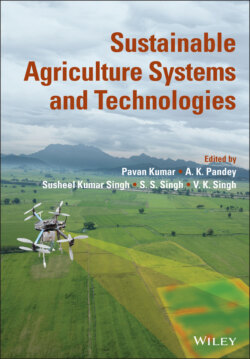Читать книгу Sustainable Agriculture Systems and Technologies - Группа авторов - Страница 33
2.5 Effect of Technology‐Induced Crop Diversification
ОглавлениеThe advancement in technological development especially development of high yielding and biotic, abiotic resistant varieties, of wide window of growing period, CA‐based systems, land configuration, and other improved agronomic management, along with increasing value addition and better postharvest handling are the encouraging forces for promotion of crop diversification in different parts of the country. Green revolution technologies intensified cropping system in irrigated areas in favor of rice and wheat and other crops got less acreage due to low productivity and less profitability. This enhanced total output of cereals tremendously but also created second generation problems like intensive use of chemical fertilizers, pesticides, etc., led to pollution of resource base, overexploitation of groundwater resulted in depletion of ground water, salinization. This made urgent call for crop diversification to achieve sustainable high levels of productivity with conservation of natural resource base and to secure higher profitability to the farmers in the long run. Rice–wheat acreages increase substantially in Indo‐Gangetic plains (IGPs) zone due to better irrigation infrastructures and higher response to the applied inputs for long time. Also, the government support system was developed over the period to safeguards the interest of the cereal growers through better pricing, input supply, and other incentives like increased availability of quality seed of improved varieties to the farmers. Later the stockholders including the farmers realized the faults in the ongoing cereal‐based system and promoted crop diversification in originally green revolution areas.
The technological development in all sectors of crop production also promoted farmers awareness to explore for crop diversification. High yielding varieties, suited to different ecologies, were developed in oilseeds, pulse crops, and millets and improved agronomic practices. These also helped in harnessing higher productivity from the diversified cropping system. The better minimum support price of the millets, oilseeds, and pulses also help in increasing the farmers’ awareness for bringing more and more area under crop diversification. The inclusion of leguminous crop not only helps in maintaining optimum soil fertility but also helps in minimizing the impact of biotic and abiotic stresses among the crop plants due to alteration in host–pathogen relationship. It helped in maintaining over all ecological balance in agriecosystem.
The date of sowing is considered as the simplest agronomic management to minimize the impact of climate change/variability on crop growth and productivity. It will be helpful to make contingency planning to fit proper variety to extreme weather conditions like raising and decreasing temperatures, varying rainfall and other weather components. The climate smart varieties would be used in large scale on farmers' field. The diversification of cereal‐based cropping systems with the crops such as oilseed, pulse, and forage crops, is another option for minimizing biotic and abiotic stresses. The pathogenic cycles could be broken up through crop substitution (Singh et al. 2002, 2020; Rathore and Bhatt 2008). Consistent practicing of monocropping resulted in loss of soil fertility, decline of soil health, factor productivity decline and lowering crop productivity even under high productivity areas (Saha et al. 2012). Conservation tillage also promotes greater soil biodiversity thereby leading to more biotic stresse suppression. Proper pest management is a permanent challenge to the farmers, and it is a very important ecosystem service, which can be restored through crop diversification. The erosion of genetic diversity led to an increase in crop disease occurrence. Greater varietal and species richness reduce the spread of disease in agricultural systems. Habitat management in agricultural systems is an effective means to enhance natural enemies. These have been developed for effective application in crop, at farm, and few of these are reported be very economically useful for the farmers. Gurr et al. (2003). The diversity of crop species within the agro ecosystem consequently offers long‐term pest suppression by building up potential natural enemies for any pest outbreaks.
